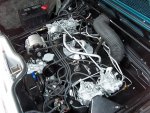erco
Senior Member
I'm officially mad at myself for not thinking of this product, which IMO could have been done with a Picaxe.
I've been AWOL from the forums for a long time now, focusing on getting my old classic car back on the road. Everyone says "I wish I kept my first car." Well I'm the idiot who did. In 1980 in college I bought a 1967 Chevy Corvair, mainly because it's a weird car. I like weird stuff. Rear engine, air cooled, kinda Volkswagen-ish. More recently, it sat rusting in my garage for 22 years while life happened. Then it became my Covid project in 2020, mostly back-burner but finally I pushed this year to get it driving. Body is still rough (I'll get to that eventually) but she's mostly new underneath from bumper to bumper. 3 years of rebuilding the front & rear suspension, all brakes, electrical, fuel tank, engine, differential, transmission, wheel bearings, etc. She drives great now and I'm having a ball:
Anyway, now I'm back into gas and carburetors (my car has 4) and engine tuning. Hey, EVs are the future so I want to enjoy my gas car while I can. Youtuber "Thunderhead289" has come up with a new microcontroller system to adjust the air/fuel ratio on the fly. I think Luke's "Carb Cheater" is the coolest thing I've ever seen to bring old cars into the future. Basically he installs a plate under the existing carburetor to introduce air into the intake manifold and adjust the air/fuel (A/F) ratio on the fly, using a controllable air bleed and a wideband air/fuel sensor. Simple but effective. It's a standalone system but it Bluetooths to your phone for customizing and datalogging.
Man it's ingenious. Should have been me but Luke beat me to it. He's selling the whole system for under $400 USD, that's dirt cheap IMO. It won't fit my Corvair but he's got me thinking about how to tweak it, or build my own version. https://www.thecarbcheater.com/
I've been AWOL from the forums for a long time now, focusing on getting my old classic car back on the road. Everyone says "I wish I kept my first car." Well I'm the idiot who did. In 1980 in college I bought a 1967 Chevy Corvair, mainly because it's a weird car. I like weird stuff. Rear engine, air cooled, kinda Volkswagen-ish. More recently, it sat rusting in my garage for 22 years while life happened. Then it became my Covid project in 2020, mostly back-burner but finally I pushed this year to get it driving. Body is still rough (I'll get to that eventually) but she's mostly new underneath from bumper to bumper. 3 years of rebuilding the front & rear suspension, all brakes, electrical, fuel tank, engine, differential, transmission, wheel bearings, etc. She drives great now and I'm having a ball:
Anyway, now I'm back into gas and carburetors (my car has 4) and engine tuning. Hey, EVs are the future so I want to enjoy my gas car while I can. Youtuber "Thunderhead289" has come up with a new microcontroller system to adjust the air/fuel ratio on the fly. I think Luke's "Carb Cheater" is the coolest thing I've ever seen to bring old cars into the future. Basically he installs a plate under the existing carburetor to introduce air into the intake manifold and adjust the air/fuel (A/F) ratio on the fly, using a controllable air bleed and a wideband air/fuel sensor. Simple but effective. It's a standalone system but it Bluetooths to your phone for customizing and datalogging.
Man it's ingenious. Should have been me but Luke beat me to it. He's selling the whole system for under $400 USD, that's dirt cheap IMO. It won't fit my Corvair but he's got me thinking about how to tweak it, or build my own version. https://www.thecarbcheater.com/
Last edited:



